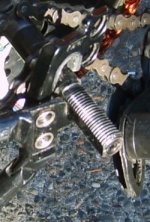blue badger
1 mW
- Joined
- Apr 5, 2010
- Messages
- 12
<Dr. Nick> Hi, everybody! </Dr. Nick>
I've been lurking these boards for a few months now, gathering information on electric bikes. The idea of a bike with an electric assist has always fascinated me, and the past few months, I've been quietly siphoning up information on these forums, planning an electric bike build. I got as far as getting the hub motor from ebikes.ca, a 48V 10Ah battery from Li Ping (though I missed the fact that it didn't come with Anderson powerpole connectors until a few days before the battery arrived, something I've since addressed), and I had a bike in mind to put it all together on. I got a 9C 26" rear hub motor, which I wanted to put into a Dahon Jack folding bike. The idea was to have an electric bike with sufficiently large diameter tires to ease handling, but could also be folded up and put into a car or moved indoors relatively easily.
I've hit a bit of a snag, though - the mechanic I delegated the project to contacted me, and told me that the axle does not fit perfectly in the rear dropouts - specifically, the motor's axle hangs past the dropout by 4-5mm. I haven't yet had a chance to take a look to snap any pictures, so I want to ask anyone who's had experience with installing a 9C rear motor - is there any solution that would allow me to properly fit this motor into a Dahon Jack (or any bike with vertical rear dropouts, for that matter), or is it time to look for another bike for the project, and just throw the idea of putting it on a folder out the window? I've done a lot of research, but I never came across anything that suggested this would be a problem, so I want to know what my options are.
I've been lurking these boards for a few months now, gathering information on electric bikes. The idea of a bike with an electric assist has always fascinated me, and the past few months, I've been quietly siphoning up information on these forums, planning an electric bike build. I got as far as getting the hub motor from ebikes.ca, a 48V 10Ah battery from Li Ping (though I missed the fact that it didn't come with Anderson powerpole connectors until a few days before the battery arrived, something I've since addressed), and I had a bike in mind to put it all together on. I got a 9C 26" rear hub motor, which I wanted to put into a Dahon Jack folding bike. The idea was to have an electric bike with sufficiently large diameter tires to ease handling, but could also be folded up and put into a car or moved indoors relatively easily.
I've hit a bit of a snag, though - the mechanic I delegated the project to contacted me, and told me that the axle does not fit perfectly in the rear dropouts - specifically, the motor's axle hangs past the dropout by 4-5mm. I haven't yet had a chance to take a look to snap any pictures, so I want to ask anyone who's had experience with installing a 9C rear motor - is there any solution that would allow me to properly fit this motor into a Dahon Jack (or any bike with vertical rear dropouts, for that matter), or is it time to look for another bike for the project, and just throw the idea of putting it on a folder out the window? I've done a lot of research, but I never came across anything that suggested this would be a problem, so I want to know what my options are.


